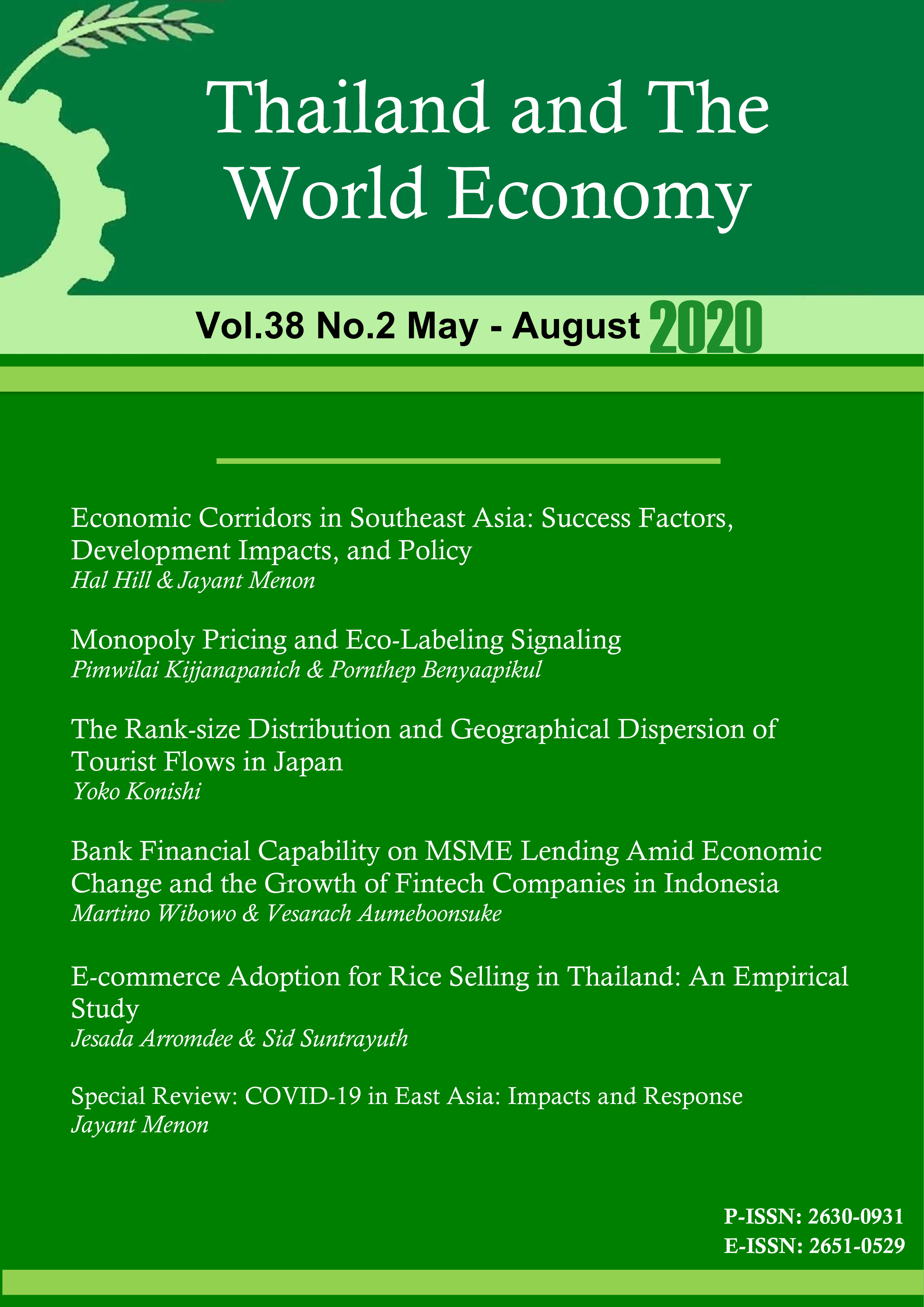Economic Corridors in Southeast Asia: Success Factors, Development Impacts, and Policy
Keywords:
Economic corridors, economic geography, Southeast AsiaAbstract
Economic corridors have gained popularity as a potentially important instrument in the development and transformation of low and middle income economies. But why have some countries had more success with them than others? What role does governance, institutions, finance and policy frameworks play in determining their success? How can we measure their impacts? We try and answer these questions by looking closely at, and drawing lessons from, two case studies of successful corridors in Asia- Malaysia and Thailand. A key conclusion is that economic corridors are more likely to succeed with greater domestic spillovers when the physical and policy infrastructure are conducive.
References
Asian Development Bank (2005). Mekong regional economic outlook, Manila.
Asian Development Bank (2015). Thematic evaluation study on ADB’s efforts on regional cooperation and integration, Manila.
Athukorala, P.C. (2014a). Global production sharing and trade patterns in East Asia, eds. by Kaur, I., & Singh, N. in The Oxford handbook of the economics of the Pacific Rim, Oxford University Press, Oxford.
Athukorala, P.C. (2014b). Growing with global production sharing: The tale of the Penang export hub, Malaysia. Competition and Change, 18 (3), 221-245.
Athukorala, P.C., & Narayanan, S. (2018). Economic corridors and regional development: The Malaysian experience. World Development, 106 (2018)1-14.
Brunner, H.P. (2013). What is economic corridor development and what can it achieve in Asia's subregions?. ADB Working Paper No. 117, Manila: Asian Development Bank.
Cheng, L. (2016).Three questions on China's “belt and road initiative”.China Economic Review, 40(2016), 309-313.
Deep, A., Kim, J., & Lee, M. (2019). Realizing the potential of public-private partnerships to advance Asia’s infrastructure development, ADB, Manila.
Fujita, M., Krugman, P., & Venables, A.J. (1999). The spatial economy: Cities, regions, and international trade. MIT Press, Cambridge, Mass.
Gordon, R. (2016). The rise and fall of American growth. The Princeton Economic Series of the Western World, Princeton, New Jersey.
Hasan, R. (2016). India’s east coast economic corridor’, paper presented to ADB Workshop, Manila.
Huang, Y. (2016). Understanding China's belt & road initiative: Motivation, framework and assessment. China Economic Review, 40(c),314-321.
Hurley, J., Morris, S., & Portelance, G. (2019). Examining the debt implications of the belt and road initiative from a policy perspective. Journal of Infrastructure, Policy and Development, 3(1),139-175.
Hutchinson, F.E. (2013). Architects of growth? Subnational governments and industrialization in Asia, Institute of Southeast Asian Studies, Singapore.
Krongkaew, M. (2017). Collection of papers on law and economics of anti-corruption actions in Thailand. National Institute of Development Administration, Bangkok.
Krugman, P. (1991). Geography and trade. MIT Press, Cambridge Mass.
Lee, M., Han, X., Gaspar, R., & Alano, E. (2018). Deriving macroeconomic benefits from public-private partnerships in developing Asia. ADB Economics Working Paper No. 551, Manila: Asian Development Bank.
Leigland, J. (2018). Public-private partnerships in developing countries: The emerging evidence-based critique. The World Bank Research Observer, 33 (1), 103-134.
Llanto, G.M. (2016). Philippine infrastructure and connectivity: Challenges and reforms. Asian Economic Policy Review, 11 (2), 243-261.
McCawley, P. (2015). Infrastructure policy in Indonesia, 1965-2015: A survey. Bulletin of Indonesian Economic Studies, 51 (2), 263-285.
McCawley, P. (2017). Banking on the future of Asia and the pacific: 50 Years of the Asian Development Bank. Retrieved from https://www.adb.org/sites/default/ files/publication/235061/adb-history-book-second-edition.pdf
Martinez-Vazquez, J., & McNab, R. (2003). Fiscal Decentralization and Economic Growth.World Development, 31 (9), 1597-1616.
Menon, J.,& Warr P. (2008). Does road improvement reduce poverty? A general equilibrium analysis for Lao PDR, eds. By Brooks, D., & Menon, J. in Infrastructure and trade in Asia. Edward Elgar, Cheltenham, 115-42.
Nathan, M. and Overman, H. (2013). Agglomeration, clusters, and industrial policy. Oxford Review of Economic Policy, 29 (2) 383-404.
Northern Corridor Implementation Authority (NCIA) (2018). Annual Report 2018. Retrieved from https://www.ncer.com.my/publications/
Park, C.Y., & Lee J.W. (2011). Integration in emerging Asia: Challenges and prospects. Asian Economic Policy Review, 6 (2), 176-198.
Rimmer, P. (2018). China's belt and road initiative: Underlying economic and international relations dimensions. Asian-Pacific Economic Literature, 32 (2), 3-26.
Rimmer, P.J., & Dick, H. (2012). Economic space for transnational infrastructure: Gateways, multimodal corridors and special economic zones, eds. by Bhattacharyay, B.N., Kawai, M., & Nag, R.M. in Infrastructure for Asian connectivity, Edward Elgar, Cheltenham, 217-253.
Rolland, N. (2017). China's Eurasian century?: Political and strategic implications of the belt and road initiative. Retrieved from https://www.nbr.org/publication/ chinas-eurasian-century-political-and-strategic-implications-of-the-belt-and-road-initiative/
Sandee, H. (2016). Improving connectivity in Indonesia: The challenges of better infrastructure, better regulations and better coordination. Asian Economic Policy Review, 11 (2), 222-238.
Singh, P., & R. Kathuria (2016). Infrastructure and connectivity in India: Getting the basics right, Asian Economic Policy Review, 11 (2), 266-285.
Summers L.H. 2016. The age of secular stagnation. Foreign Affairs 95(2), 2-9.
Swaine, M.D. (2015). Chinese views and commentary on the ‘one belt, one road’ initiative’, China Leadership Monitor, 47, 1-24.
Timmer, C. Peter. 2016. Land and development in Indonesia: Searching for the people's sovereignty. Bulletin of Indonesian Economic Studies, 52(3), 409–11.
Warr, P., & A. Kohpaiboon (2018). Explaining Thailand’s automotive manufacturing success. Journal of Southeast Asian Economies 35 (3), 425-448.
WEF (World Economic Forum) (2016). Competitive cities and their connections to global value chains. Retrieved from http://www3.weforum.org/docs /WEF_2016 _WhitePaper _GAC_Competitive_Cities_.pdf
Wells, L.T., & Ahmed, R. (2006). Making foreign investment safe: Property rights and national sovereignty, Oxford University Press, Oxford.
Witte, P. (2014). European corridors as carriers of dynamic agglomeration economies. European Planning Studies, 22 (11), 2326-2350.
Wolff, P. (2016). China's ‘belt and road’ initiative – challenges and opportunities. Retrieved from https://www.die-gdi.de/uploads/media/Belt _and_Road _V1.pdf










